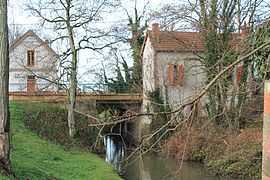Grossouvre
| Grossouvre | ||
|---|---|---|
|
A house and bridge in Grossouvre | ||
| ||
 Grossouvre | ||
|
Location within Centre region  Grossouvre | ||
| Coordinates: 46°52′46″N 2°56′17″E / 46.8794°N 2.9381°ECoordinates: 46°52′46″N 2°56′17″E / 46.8794°N 2.9381°E | ||
| Country | France | |
| Region | Centre-Val de Loire | |
| Department | Cher | |
| Arrondissement | Saint-Amand-Montrond | |
| Canton | Sancoins | |
| Intercommunality | Trois Provinces | |
| Government | ||
| • Mayor (2008–2014) | Michel Monseau | |
| Area1 | 15.75 km2 (6.08 sq mi) | |
| Population (2008)2 | 296 | |
| • Density | 19/km2 (49/sq mi) | |
| INSEE/Postal code | 18106 / 18600 | |
| Elevation |
182–230 m (597–755 ft) (avg. 206 m or 676 ft) | |
|
1 French Land Register data, which excludes lakes, ponds, glaciers > 1 km² (0.386 sq mi or 247 acres) and river estuaries. 2 Population without double counting: residents of multiple communes (e.g., students and military personnel) only counted once. | ||
Grossouvre is a commune in the Cher department in the Centre region of France.
Geography
A village of farming, forestry and a little light industry situated by the banks of both the Aubois river and the canal de Berry some 23 miles (37 km) southeast of Bourges at the junction of the D76, D78 and the D920 roads.
The valley is situated on the crossroads of three ancient provinces: Nivernais to the east, le Bourbonnais to the south, and Berry and is on the edge of the departements of Nièvre and Allier. Though rural today and suffering from rural depopulation-in the Middle Ages it had all the natural resources to make it a centre of metallurgy (iron and steel production) and extractive industries (sand, chalk and clay for bricks and tiles). [1]
Sights
- The nineteenth-century church of St. Pierre.
- The chateau, built over a castle dating from the twelfth century.
- The Espace Métal - Halle de Grossouvre museum of industry
See also
References
External links
| Wikimedia Commons has media related to Grossouvre. |
- Grossouvre on the Quid website (French)

.svg.png)